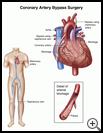
Coronary Artery Bypass Surgery
________________________________________________________________________
KEY POINTS
- Coronary artery bypass surgery uses blood vessels or manmade material to make a new path around the narrow or blocked area of your coronary artery. Coronary arteries are the blood vessels that carry oxygen and nutrients to the heart.
- Ask your provider how long it will take to recover and how to take care of yourself at home.
- Make sure you know what symptoms or problems you should watch for and what to do if you have them.
________________________________________________________________________
What is coronary artery bypass surgery?
Coronary artery bypass surgery is a surgery to get more blood to the heart muscle when your coronary arteries are severely narrowed or blocked. Coronary arteries are the blood vessels that carry oxygen and nutrients to the heart.
Bypass surgery uses blood vessels from other parts of the body, or manmade material, to make a new path around the blocked area of an artery. The oxygen-rich blood is then able to flow around, or bypass, the blockage and get to the heart muscle. If more than 1 artery is blocked, you may need more than 1 bypass.
When is it used?
Fatty deposits called plaque may build up in blood vessels and make them narrow. The narrowing means less blood flows through the vessels. Plaque also increases the chance that blood clots may form and block a blood vessel, which can cause a heart attack or stroke.
To treat blocked arteries, you may first try lifestyle changes such as diet and exercise, medicines, or angioplasty, which is a procedure to open the arteries without major surgery. If your arteries are still badly blocked after these treatments, your healthcare provider may recommend bypass surgery.
Ask your healthcare provider about your choices for treatment and the risks.
How do I prepare for this procedure?
- Make plans for your care and recovery after you have the procedure. Allow for time to rest and try to find other people to help with your day-to-day tasks while you recover.
- You may or may not need to take your regular medicines the day of the procedure. Tell your healthcare provider about all medicines and supplements that you take. Some products may increase your risk of side effects. Ask your healthcare provider if you need to avoid taking any medicine or supplements before the procedure.
- Tell your healthcare provider if you have any food, medicine, or other allergies such as latex.
- Because you may need blood transfusions during the operation or during recovery, you may want to donate some of your own blood before the procedure. Ask your healthcare provider about this.
- Your healthcare provider may prescribe medicine to prevent blood clots from forming during and after the procedure.
- Your healthcare provider will tell you when to stop eating and drinking before the procedure. This helps to keep you from vomiting during the procedure.
- Follow any other instructions your healthcare provider gives you.
- Ask any questions you have before the procedure. You should understand what your healthcare provider is going to do. You have the right to make decisions about your healthcare and to give permission for any tests or procedures.
What happens during the procedure?
The procedure will be done at the hospital.
You will be given a general anesthetic to keep you from feeling pain. General anesthesia relaxes your muscles and you will be asleep.
Your healthcare provider will make a cut in your chest and you will be connected to a machine that will do the work of your heart and lungs during the surgery.
Your healthcare provider will cut out one or more blood vessels from your leg, arm, or chest to be used to make new paths around blocked coronary arteries. When the bypass is done, your healthcare provider will close the cut in your chest.
The operation takes 2 to 6 hours, depending on how many blood vessels need to be bypassed.
What happens after the procedure?
After surgery, you will go to the intensive care unit (ICU). The average amount of time to stay in the hospital after bypass surgery is a week or more.
Your healthcare provider will prescribe an exercise program called cardiac rehabilitation to help you get back to your normal activities slowly and safely.
You may have some pain, nausea, vomiting, or constipation after the procedure. Your healthcare provider may give you medicine or recommend other ways to help these problems.
Follow your healthcare provider's instructions. Ask your provider:
- How long it will take to recover
- If there are activities you should avoid and when you can return to your normal activities
- How to take care of yourself at home
- What symptoms or problems you should watch for and what to do if you have them
Make sure you know when you should come back for a checkup. Keep all appointments for provider visits or tests.
What are the risks of this procedure?
Every procedure or treatment has risks. Some possible risks of this procedure include:
- You may have problems with anesthesia.
- You may have infection, bleeding, or blood clots.
- There is a risk of stroke during and after the operation.
- You may have abnormal heart rhythms, which can be treated.
Ask your healthcare provider how these risks apply to you. Be sure to discuss any other questions or concerns that you may have.

